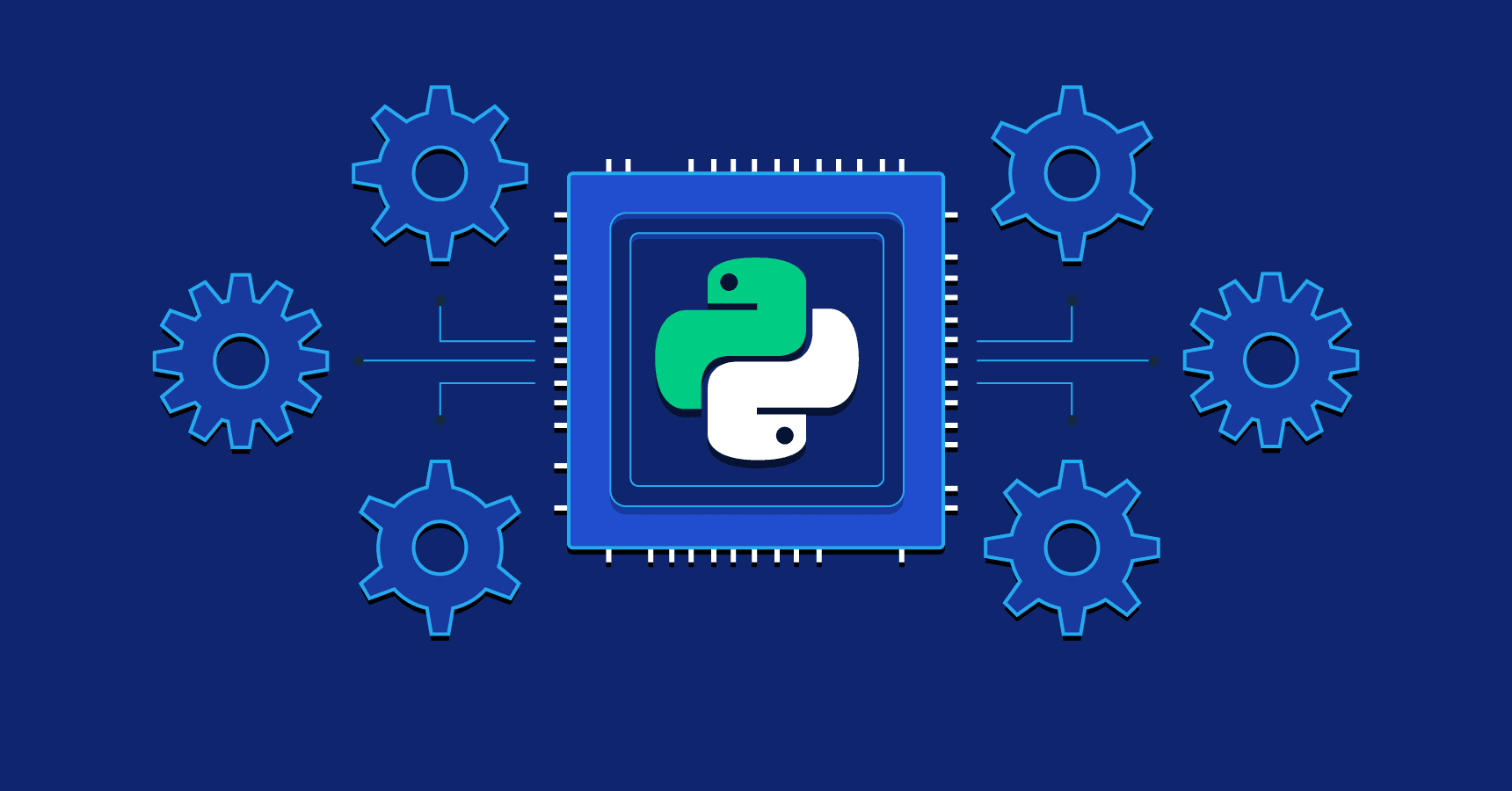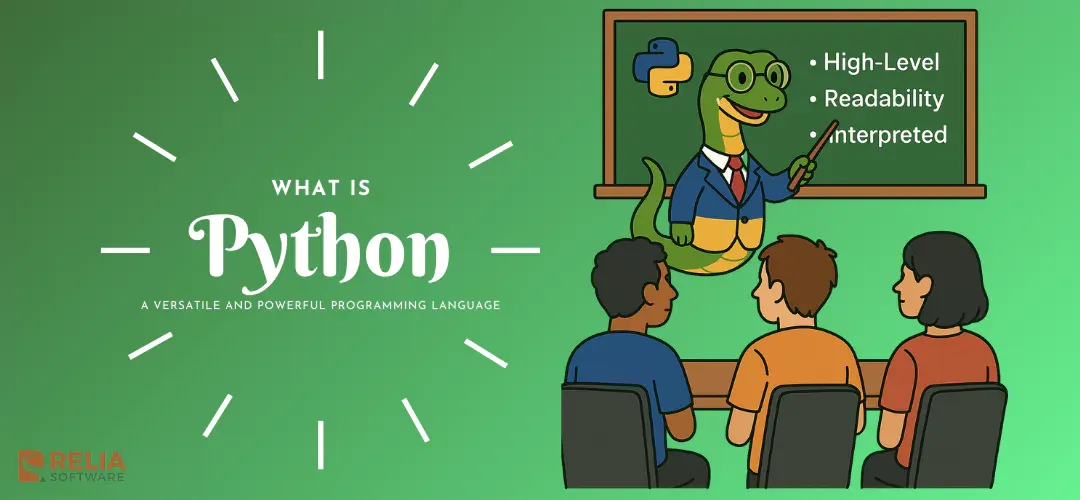Python, a versatile and powerful programming language, has gained immense popularity among beginners and experienced programmers alike. Known for its simplicity, readability, and extensive range of libraries and frameworks, Python has become the language of choice for various applications, from web development to data analysis and machine learning.
In this article, Relia Software will provide a comprehensive introduction to Python, exploring its origins, features, syntax, and applications. Whether you’re a novice programmer or looking to expand your coding skills, this guide will be a solid foundation to start your Python journey.
>> Read more about other languages:
- The Golang Programming Language: Definition & Practical
- Building Front-End Applications with React
What is Python?
Python is a high-level programming language known for its simplicity, readability, and versatility. It was created by Guido van Rossum and first released in 1991. Python has gained significant popularity and has become one of the world’s most widely used programming languages.
Python emphasizes code readability, with a clear and straightforward syntax allowing programmers to express concepts in fewer lines of code than other languages. It supports multiple programming paradigms, including procedural, object-oriented, and functional programming.
Python offers a vast standard library and a thriving ecosystem of third-party libraries and frameworks, making it suitable for various applications. It can be used for web development, scientific computing, data analysis, artificial intelligence, machine learning, automation, scripting, and more.
One of the key features of Python is its dynamic typing, which means you don’t need to declare variable types explicitly. Python also has automatic memory management, handled by a garbage collector, which makes it easier for developers to focus on writing code rather than managing memory.
Python has an interactive mode interpreter that allows you to execute code line by line, making it a great language for beginners to learn and experiment with. It is available on various platforms, including Windows, macOS, Linux, etc.
Why is Python So Popular?
Python offers several features that contribute to its popularity and makes it an ideal language for beginners:
- Readability: Python emphasizes clean and concise code, using indentation to denote code blocks instead of traditional braces or keywords. This makes Python code highly readable and easy to understand.
- Simplicity: Python’s straightforward syntax allows developers to express concepts with fewer lines of code than other languages. It avoids unnecessary complexity, enabling beginners to grasp programming concepts quickly.
- Versatility: Python is a versatile language supporting procedural and object-oriented programming paradigms. It provides a wide range of libraries and frameworks, making it suitable for various applications.
- Large Standard Library: Python has a comprehensive standard library offering a rich collection of modules and functions. These modules cover many tasks, including file I/O, regular expressions, networking, and more, allowing developers to accomplish complex tasks with minimal effort.
- Platform Independence: Python is a cross-platform language, meaning code written in Python can run on different operating systems without requiring modifications. This feature makes it highly portable and convenient for developers.
Python Syntax
Python’s syntax is designed to be simple and intuitive. Let’s explore some fundamental elements of Python syntax:
Variables and Data Types: In Python, you can assign values to variables using the “=” operator. Python supports various data types, including integers, floats, strings, booleans, lists, tuples, and dictionaries.
Control Structures: Python provides control structures such as if-else statements, loops (for and while), and switch-case (implemented using dictionaries). These structures allow you to make decisions and repeat code based on certain conditions.
Functions: Functions are a fundamental building block in Python. They allow you to group a set of instructions and reuse them whenever needed. Python also supports the creation of anonymous functions using lambda expressions.
Modules and Packages: Python’s modular approach enables developers to organize their code into reusable modules. A module is a file containing Python definitions and statements, while a package is a collection of modules organized in directories. Modules and packages facilitate code reuse and maintainability.
Exception Handling: Python provides robust mechanisms for handling exceptions, allowing developers to gracefully handle runtime errors and exceptions that may occur during program execution.

Python’s Common Libraries and Frameworks
Python has a vast ecosystem of libraries and frameworks that extend its capabilities and simplify various programming tasks. Here are some popular libraries and frameworks in Python:
NumPy
NumPy is a fundamental library for scientific computing in Python. It provides support for large, multi-dimensional arrays and matrices, along with a collection of mathematical functions. NumPy is widely used in fields such as data analysis, numerical simulations, and machine learning.
Pandas
Pandas is a powerful library for data manipulation and analysis. It offers data structures and functions to efficiently handle structured data, such as tables and time series. Pandas is commonly used in data preprocessing, cleaning, exploration, and transformation tasks.
Matplotlib
Matplotlib is a plotting library that enables the creation of static, animated, and interactive visualizations in Python. It provides a wide range of customizable plots, including line plots, scatter plots, bar plots, histograms, and more. Matplotlib is often used for data visualization and exploration.
TensorFlow
TensorFlow is an open-source library for machine learning and deep learning developed by Google. It provides tools and APIs for building and training neural networks. TensorFlow offers a flexible architecture for creating complex models and is widely used in areas such as image recognition, natural language processing, and reinforcement learning.
PyTorch
PyTorch is another popular library for deep learning. It offers a dynamic computational graph and a range of tools for building and training neural networks. PyTorch’s ease of use and flexibility make it a preferred choice for researchers and practitioners in the field of deep learning.
Scikit-learn
Scikit-learn is a comprehensive library for machine learning algorithms and tools. It provides a wide range of supervised and unsupervised learning algorithms, as well as utilities for model selection, evaluation, and preprocessing. Scikit-learn is widely used for tasks such as classification, regression, clustering, and dimensionality reduction.
Django
Django is a high-level web framework that simplifies web development in Python. It follows the Model-View-Controller (MVC) architectural pattern and provides a set of tools and conventions for building secure and scalable web applications. Django handles tasks such as URL routing, database management, user authentication, and template rendering.
Flask
Flask is a lightweight web framework that is easy to learn and use. It focuses on simplicity and extensibility, allowing developers to create web applications with minimal boilerplate code. Flask provides a basic set of features for routing, templating, and request handling, while also allowing for easy integration with other libraries and tools.
Keras
Keras is a high-level neural networks API that runs on top of TensorFlow, CNTK, or Theano. It provides a user-friendly interface for building and training deep learning models. Keras simplifies the process of prototyping and experimenting with different architectures, making it a popular choice for beginners and researchers.
SQLAlchemy
SQLAlchemy is a popular library for working with databases in Python. It provides a high-level, SQL-agnostic interface for interacting with relational databases, allowing developers to write database-agnostic code. SQLAlchemy supports various database engines and offers powerful features for querying, mapping objects to databases, and managing database connections.
What is Python used for?
Python’s versatility makes it suitable for a wide range of applications:
Web Development
Python is often used to develop the back end of a website or application—the parts that a user doesn’t see. Python’s role in web development includes sending data to and from servers, processing data and communicating with databases, routing URLs, and ensuring security.
Python’s web frameworks, such as Django and Flask, empower developers to create dynamic and scalable web applications. Python’s ease of use and rich ecosystem make it a preferred language for web development.
Some web development jobs that use Python include back-end engineers, full-stack engineers, Python developers, software engineers, and DevOps engineers.
Data Analysis and Visualization
Python has become a staple in data science, allowing data analysts and other professionals to use the language to conduct complex statistical calculations, create data visualizations, build machine learning algorithms, manipulate and analyze data, and complete other data-related tasks.
Python can build a wide range of different data visualizations, like line and bar graphs, pie charts, histograms, and 3D plots. Python also has a number of libraries that enable coders to write programs for data analysis and machine learning more quickly and efficiently, like TensorFlow and Keras. Python’s syntax and extensive data processing capabilities make it popular for data scientists and analysts.
Machine Learning and Artificial Intelligence
Python’s libraries, including TensorFlow, PyTorch, and scikit-learn, enable developers to build and train machine learning models efficiently. Python’s simplicity and community support have made it a dominant language in AI.
>> You may be interested in:
Automation and Scripting
If you perform a task repeatedly, you can work more efficiently by automating it with Python. Writing code used to build these automated processes is called scripting. In the coding world, automation can be used to check for errors across multiple files, convert files, execute simple math, and remove duplicates in data.
Relative beginners can even use Python to automate simple tasks on the computer—such as renaming files, finding and downloading online content or sending emails or texts at desired intervals.
Python’s ease of use and versatility make it ideal for automation and scripting tasks. Whether automating repetitive tasks, writing system administration scripts, or creating simple command-line tools, Python excels in simplifying these tasks.
Game Development
Python offers libraries like Pygame that simplify game development by providing graphics rendering, audio, and user input handling tools. While Python might not be the first choice for high-performance games, it’s a great language for prototyping and developing casual games.
Conclusion
Python’s popularity continues to grow due to its simplicity, readability, and extensive ecosystem. Its versatility enables developers to tackle various applications, from web development to data analysis and machine learning.
With its beginner-friendly syntax and rich libraries and frameworks, Python is an excellent entry point for aspiring programmers. Whether you’re embarking on your coding journey or looking to expand your skills, mastering Python will open up a world of opportunities in the dynamic programming field.
>> Follow and Contact Relia Software for more information!
- Mobile App Development
- coding
- Web application Development

